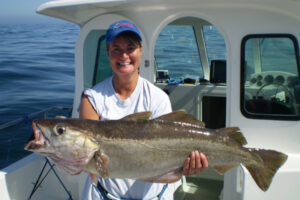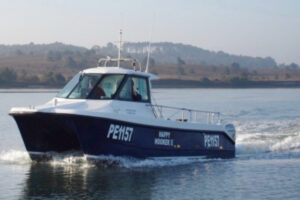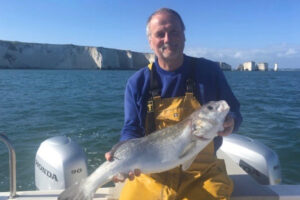Mark Blanchard spends a day with husband and wife team Annie and Ian Gilbert, who have been fishing together off the Dorset and Isle of Wight coast for the past two decades
Keeping shop with your partner must test any relationship. Factor in 14-hour days at sea on a 7m fast cat and it is pushed to another dimension – but that’s what rod and line fishers Annie and Ian Gilbert do successfully every day.
The couple, whose main target is prime-quality bass, work out of the picturesque inlet of Ridge on the river Frome, set deep in the backwaters of Poole Harbour.
However, that is where the tranquillity ends.
They are a very serious enterprise, fishing an 800-square- mile area between St Alban’s Head to the west and St Catherine’s Point on the Isle of Wight to the east, and up to 30 miles offshore.
Annie, who is one of the small but growing number of women making their way in the catching sector, was born in the Midlands, but moved to the Dorset coast with her parents when she was just two. That’s pretty much when it all started – shortly after moving south, her dad bought a boat, taking Annie to sea with him as often as possible. She soon had salt running through her veins.

Annie shows off a prime pollack.
Twenty years ago, Ian came on the scene – he was already a keen angler, but not fishing for a living at the time. Annie started working for Ian in an unrelated business, and they soon realised that not only did they share a passion for angling, but also for each other.
In a short space of time they not only got married, but also started a fishing business together. They both told me that neither decision took a lot of consideration – and listening to them chat, I was left in no doubt that their instincts were sound.
They went 50/50 on the purchase of their first boat, an Orkney 21 Commercial, and named her Happy Hooker.
Ian said: “She was a great starter boat and we certainly ‘cut our teeth’ with her. We tried a lot, and learnt a lot – some bits were far more successful than others.”
Bass was always the main part of their fishing, but in winter they also had cod coming up on the hooks, alongside trammel-netting for Dover sole in the autumn. The boat was small and versatile, without clutter – nets were hand-hauled, which Annie tells me was heavy going at times. She ended up with very strong arms, and certainly never felt the need to join a gym.
After five years, and a very rough 15-mile trip home one night in what is a relatively small open boat, it became obvious that they needed a bigger boat.
All was going well, but upgrading is a massive move. Undeterred, it was off to the bank to remortgage the house – there’s confidence for you!
They decided to go full hog, and went for a new-build Cheetah cat with twin 90hp Honda engines – the cost in 2009, including the licence, exceeded £70,000. Looking back, they both agree that the repayments were a pretty scary thought at the time, when their primary source of income was earned with a fishing rod.
The new boat, named Happy Hooker II, certainly opened up their fishing opportunities. When bass were scarce, they could steam up to 25 miles off, working a series of wrecks for pollack, which were making between £7 and £8 per kg at the time, and definitely helped keep the wolf from the door in the early days.

Annie and Ian Gilbert’s 2009-built Cheetah cat Happy Hooker II on the hard at Ridge for her annual refit.
They fitted a net hauler for a while to keep options open when various bass restrictions were being discussed, but found it took up a lot of boat space and created additional weight for little use, so removed it again. They can still just about still hand-haul nets on slack water if the need arises.
Catching bass on a rod is an art – one I’ve never managed to master – but Annie and Ian have it off to a tee. There are so many factors to throw into the mix, long before you actually start putting fish in the box: bait, tide, east wind, time of year, high pressure, other boats disturbing the peace, you name it…
The fishing pattern onboard the Happy Hooker II is pure music. They use a single rod each, and compete for the first fish – Annie tells me she is head and shoulders in front on that one. Once the drift is complete, Ian is back on the wheel positioning the boat for the next drift, while Annie stuns the fish, cuts their gills with precision, and places them in a tray to bleed. After the next drift, she thoroughly washes each individual fish, meticulously places them on their backs in boxes, and adds 1kg ice per 1kg fish – they are never disturbed again.
The Gilberts only had one day in 2021 of going home with a ‘blank’ – no fish. Annie says: “I’ve got a sixth sense – we can steam an hour and a half to a bank, and for some reason I’ll look up at Ian and say: ‘There’s no fish here today’, and we’ll steam further on. Don’t ask me how I know – I just do.”
Their third hand, seagull George-Bob, joins them for every trip between April and August – and is never late.
Daily catches vary between 20kg and 100kg, with prices during the year ranging between £15 per kg for small and £25/kg for large. On good weather days, at slack water they’ll swap the bass rigs for feathers, hoping for 15-20kg of mackerel to help top the day up and contribute towards the hefty fuel bill.

Seagull George-Bob accompanies every trip between April and August, in return for a daily feed of freshly caught mackerel.
The dynamics of rod and line bass fishing around this area have changed. I know that years ago when I was crabbing, having a go for bass on the spring tides appealed. In those days, the bass boys kept it a pretty closed shop. They’d say: “You need live sandeels, and they’re not easy to catch from a punt.” Then, when we worked out how to use a small beach seine for eels, it was: “Yeah, but you don’t just put ’em on the hook.”
Annie and Ian use a mix of lures and live bait depending on the time of year – but, ironically, never sandeels. Earlier in the year, their preference is for lures and sidewinders whilst targeting mainly smaller male fish; later in the year, they move to live mackerel and scad. If the live bait is not working over a couple of drifts, it’s either try the lures or try somewhere else!
Catching bass only works when the tide is running – and that’s where the simple science of that statement comes to an abrupt end! Some banks and ledges fish best on the ebb and some on the flood, some at the start of the tide and some when it’s slackening off. Only years of working the area will give you a true picture.
Sand-dredging ships regularly work the area, and often get bad press from rod and line bass fishermen for destroying banks that bass are shoaling around. Annie and Ian try to work around this, in the knowledge that when the ships’ dredge gear is over the side, the massive suction pump stirs up a lot of small crustaceans that bass feed on – so fishing close by can reap rewards.
I know that when I worked on sand ships, we often pumped up a few decent fish – cod when working the North Sea, sole or turbot on the south coast, but never bass. They all ended up in the galley! The ship’s cooks were mostly from the redundant Icelandic trawler fleet, so the fish made a welcome change to the traditional ‘pot full of shackles’ on offer – a thick ‘Hull stew’.
As everyone knows, catching a prime-quality product for a high-value niche market is only part of the recipe for success – the next bit is what happens to it when the boat is back alongside the quay.
Annie and Ian have always strived to build relationships and trust when it comes to selling their fish, and they have their own cold store to serve local fishmongers. They also land on the Brixham market, driving their own fish there to ensure the quality stays pristine in the shortest possible delivery time.
The meticulous way their bass is looked after has built Annie and Ian a fantastic reputation, which has recently paid off, both saving them driving time and drastically reducing their carbon footprint.

Summer fishing off Old Harry Rocks on the Jurassic Coast.
Rockfish, run by the prestigious seafood chef and food writer Mitch Tonks, has taken the Gilberts onboard as one of its suppliers. Restaurant director Dave Strauss wanted top-quality line-caught bass, not just for his chefs to get fresh onto plates, but also to market through the Rockfish online platform. This model gives households across the UK access to an artisan product caught using the very lowest- impact fishing methods.
Brixham-based Rockfish, which has eight successful restaurants along the south coast, already runs an efficient and green distribution network serving its businesses. Collecting Annie and Ian’s fish on an almost daily basis ties in nicely with deliveries to its Poole outlet, adding no further environmental cost – who doesn’t win out of that?
What’s more, the Gilberts are paid a pre-arranged set price, which reduces the uncertainty for everyone in the loop.
Being a woman fisher, Annie has always attracted media coverage. She’s appeared on the BBC Countryfile programme, and was recently asked by BBC News to make a mini documentary on her iPad during lockdown of a couple working together in a unique job – you couldn’t have picked two better candidates!
Landing tope, John Dory and gurnard on the bass gear is not unheard of, and recently sightings of tuna are becoming far more frequent – but steaming out one morning, their stomachs turned. Annie was on deck, and thought she had spotted a head face down in the sea.
Ian came about and went alongside it – only to find, to the couple’s massive relief, that it was an American basketball with several years of weed and shell growth that looked like hair. Annie posted the photo on Instagram – it’s received over 4.5m hits!
Commercial rod and line fishing has always fascinated me, but it’s only after spending time with Annie and Ian that I really appreciate how much skill and hard work it takes. They are both true ambassadors for the industry, and with Annie’s sheer determination to forge ahead in such a tough job, she is an inspiration to the growing number of women coming into fishing.
This story was taken from the latest issue of Fishing News. For more up-to-date and in-depth reports on the UK and Irish commercial fishing sector, subscribe to Fishing News here or buy the latest single issue for just £3.30 here.








